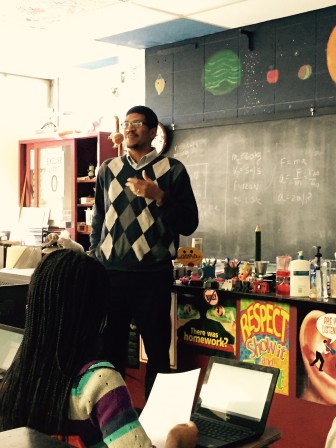Columbia High School has added a new course to the science curriculum — one that allows students to pursue independent study and work with actual researchers over three years.
The course, which debuted for a select group of 10th graders this year, is called “Science Research.”
“Science Research is brand new for us,” said Alan Levin, South Orange-Maplewood School District Supervisor of Science Grades 6 to 12. “Millburn has been doing this for at least three years. Livingston has the most experience — 9 years.” Levin said that SOMSD went right to Livingston for information. In particular, Levin thanked Livingston Science Department Chair Brian Carey for his help. Carey met with Levin, teacher Allan Tumolillo and incoming Principal Elizabeth Aaron last year when CHS was first considering a Science Research program.
Levin said that, while CHS has always supported students to do research, “it’s always been an add-on, extracurricular.” He said, “This is the first time we said, ‘Let’s make it a part of the program.'”
Science Research is a 3-year program from sophomore through senior years, culminating in each student producing a piece of research through individual study. Through the program, students must seek and connect with real-life scientific researchers who act as their mentors.
“The objective is for them to create a piece of published research that can then be entered into a science contest, state, regional, national…. We hope that each student will be able to submit. But they have to learn how to do research first. In the first year, they’re learning how to read a research paper. They report out on the paper to the other members of the class and have a dialogue about it.”
Outside researchers and presenters also visit the class. Last week, Dr. Alfred Freilich, of Seton Hall University’s Department of Physics, visited the class with one of his undergraduate students. Additionally, Dr. Joseph Freeman, CHS Class of 1993 and an associate professor of biomedical engineering at Rutgers University recently visited.
“He was spectacular,” said Levin, noting that Freeman was captain of the CHS basketball team during his time at Columbia High. Freeman, who is African American, went from CHS to Princeton University for his undergraduate degree before pursuing and obtaining his doctorate from Rutgers. “He really related to the kids.”
Science Research students need to associate with a mentor with a speciality in the field that they are studying. Levin noted, “Someone grabbed the shirt sleeve of Dr. Freeman. We hope to bring in more people from NJIT, Rutgers, Seton Hall [and more]. We’ve made connections. We’re well on our way to figuring out people to work with our students — but they will have to do some of the work themselves.”
When Levin started recruiting students from the freshman class for the Science Research program last February and March, he hoped for 20 applicants but received nearly 30 applications. Twenty-eight were accepted but for “a few it didn’t work in their schedule.” Now the class is at 24.
“Essentially almost every kid who applied was of such high caliber that we accepted them.” Levin called the plethora of qualified candidates “a wonderful problem and opportunity. There’s no reason not to believe that as many great, super kids will want to be in it next year.” Levin said he is expecting 20-25 students to join the program per year.
Besides looking for kids who have shown themselves to be strong academically, Levin said CHS was looking for all racial backgrounds and a good representation of men and women. “I feel strongly about girls doing math and science and technology. It’s not just me. If you walk into our AP science or research class, you’ll see young men and women.”
In a time of budgetary constraints, Levin says that internal advocacy is a big part of the success of such programs. “I saw an opportunity first of all, and I had a person who was a strong advocate for the class with Allan Tumolillo. It’s often that faculty person who has such a passion about ‘we need to have this.'”
Levin sees a bright future for the Science Research program: “Next year, I’ll be advocating in front of our business manager and assistant superintendent that we expand the program.”
On a recent visit to the class — which is held five days a week — students were on their third round of presentations. This particular round, said Tumolillo, was their first attempt to read and interpret a dense scientific paper in their individual area of interest.
“The papers in this round are serious professional papers from science journals – for 15/16 year olds they can be intimidating. Each speaker’s task is to briefly summarize the paper, discuss the hypothesis, what data was found, how the scientists did the experiment, is the conclusion justified from the data and so forth.”
Sydney Territo presented a 60-page paper The Unity and Diversity of Executive Functions and their Contributions to Complex Frontal Lobe Tasks. Territo was not only impressive in her presentation of the paper but in her response to questions from other students. In turn, the other students were impressive in their close listening to Territo and intelligent questions about her topic.
“It’s about your own initiative,” said Territo, when asked about the Science Research program. “I like that.” Territo explained that she was very interested in neuroscience and psychology and would consider a career path in those disciplines.
Said Levin: “We’re experimenting with this program. It’s our first time through. We’re trying to see what the kids can do.”


